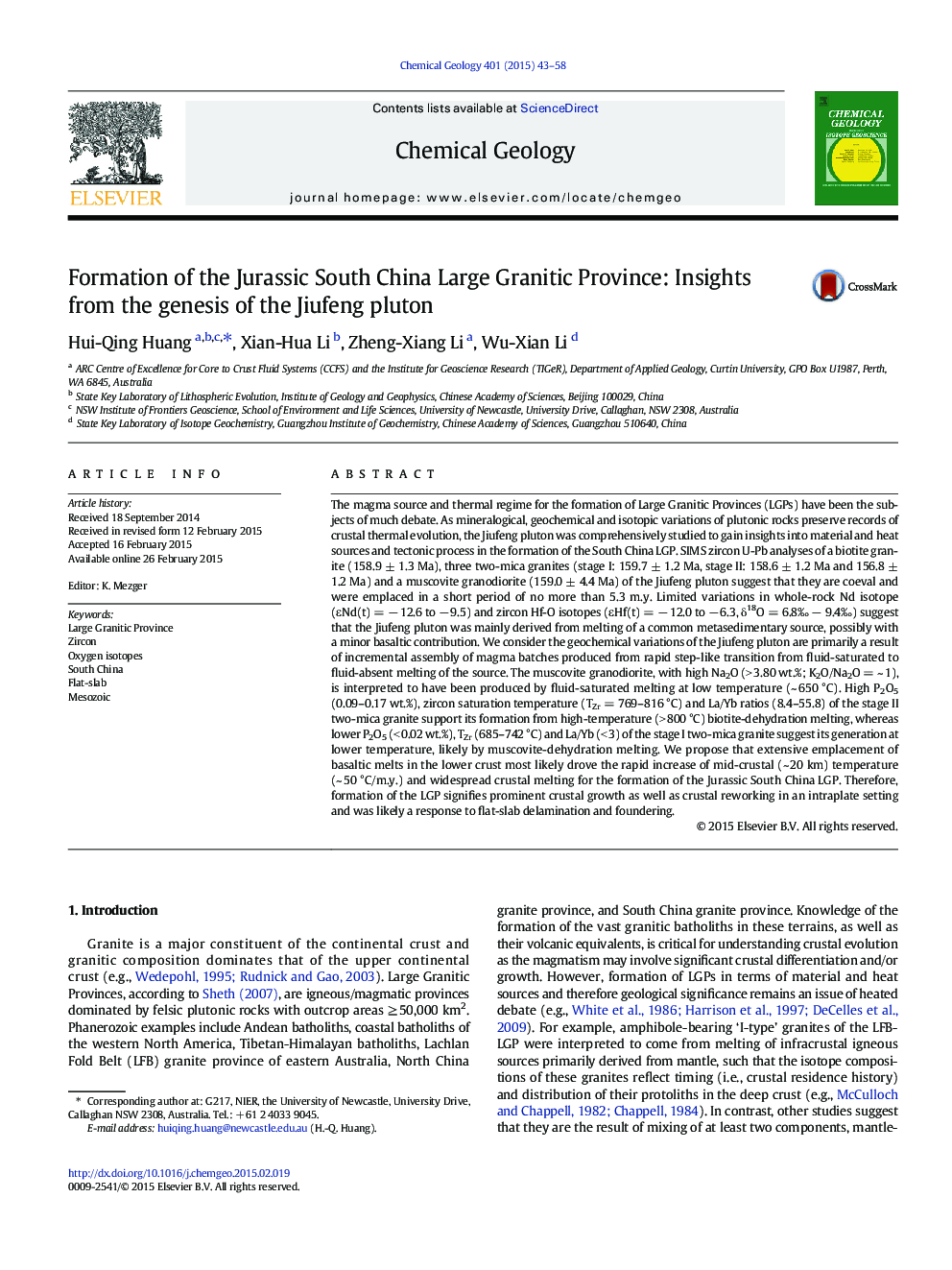| کد مقاله | کد نشریه | سال انتشار | مقاله انگلیسی | نسخه تمام متن |
|---|---|---|---|---|
| 6436425 | 1637572 | 2015 | 16 صفحه PDF | دانلود رایگان |

- Jiufeng granites were emplaced coevally and incrementally at ~Â 159Â Ma.
- A rapid transition from low to high temperature melting of a metasedimentary source.
- Basaltic intrusions led to rapid changes in crustal thermal regime (> 30 °C/Myr).
- Crustal reworking and growth are essential in Large Granitic Provinces formation.
The magma source and thermal regime for the formation of Large Granitic Provinces (LGPs) have been the subjects of much debate. As mineralogical, geochemical and isotopic variations of plutonic rocks preserve records of crustal thermal evolution, the Jiufeng pluton was comprehensively studied to gain insights into material and heat sources and tectonic process in the formation of the South China LGP. SIMS zircon U-Pb analyses of a biotite granite (158.9 ± 1.3 Ma), three two-mica granites (stage I: 159.7 ± 1.2 Ma, stage II: 158.6 ± 1.2 Ma and 156.8 ± 1.2 Ma) and a muscovite granodiorite (159.0 ± 4.4 Ma) of the Jiufeng pluton suggest that they are coeval and were emplaced in a short period of no more than 5.3 m.y. Limited variations in whole-rock Nd isotope (εNd(t) = â 12.6 to â 9.5) and zircon Hf-O isotopes (εHf(t) = â 12.0 to â 6.3, δ18O = 6.8â°Â â 9.4â°) suggest that the Jiufeng pluton was mainly derived from melting of a common metasedimentary source, possibly with a minor basaltic contribution. We consider the geochemical variations of the Jiufeng pluton are primarily a result of incremental assembly of magma batches produced from rapid step-like transition from fluid-saturated to fluid-absent melting of the source. The muscovite granodiorite, with high Na2O (> 3.80 wt.%; K2O/Na2O = ~ 1), is interpreted to have been produced by fluid-saturated melting at low temperature (~ 650 °C). High P2O5 (0.09-0.17 wt.%), zircon saturation temperature (TZr = 769-816 °C) and La/Yb ratios (8.4-55.8) of the stage II two-mica granite support its formation from high-temperature (> 800 °C) biotite-dehydration melting, whereas lower P2O5 (< 0.02 wt.%), TZr (685-742 °C) and La/Yb (< 3) of the stage I two-mica granite suggest its generation at lower temperature, likely by muscovite-dehydration melting. We propose that extensive emplacement of basaltic melts in the lower crust most likely drove the rapid increase of mid-crustal (~ 20 km) temperature (~ 50 °C/m.y.) and widespread crustal melting for the formation of the Jurassic South China LGP. Therefore, formation of the LGP signifies prominent crustal growth as well as crustal reworking in an intraplate setting and was likely a response to flat-slab delamination and foundering.
Journal: Chemical Geology - Volume 401, 24 April 2015, Pages 43-58